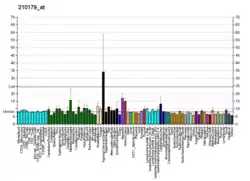KCNJ13
Potassium inwardly-rectifying channel, subfamily J, member 13 (KCNJ13) is a human gene encoding the Kir7.1 protein.[4]
| KCNJ13 | |||||||||||||||||||||||||
|---|---|---|---|---|---|---|---|---|---|---|---|---|---|---|---|---|---|---|---|---|---|---|---|---|---|
| Identifiers | |||||||||||||||||||||||||
| Aliases | KCNJ13, KIR1.4, KIR7.1, LCA16, SVD, potassium voltage-gated channel subfamily J member 13, potassium inwardly rectifying channel subfamily J member 13 | ||||||||||||||||||||||||
| External IDs | OMIM: 603208 MGI: 3781032 HomoloGene: 55638 GeneCards: KCNJ13 | ||||||||||||||||||||||||
| |||||||||||||||||||||||||
| |||||||||||||||||||||||||
| |||||||||||||||||||||||||
| Orthologs | |||||||||||||||||||||||||
| Species | Human | Mouse | |||||||||||||||||||||||
| Entrez | |||||||||||||||||||||||||
| Ensembl | |||||||||||||||||||||||||
| UniProt | |||||||||||||||||||||||||
| RefSeq (mRNA) | |||||||||||||||||||||||||
| RefSeq (protein) | |||||||||||||||||||||||||
| Location (UCSC) | Chr 2: 232.77 – 232.78 Mb | n/a | |||||||||||||||||||||||
| PubMed search | [2] | [3] | |||||||||||||||||||||||
| Wikidata | |||||||||||||||||||||||||
| |||||||||||||||||||||||||
References
- GRCh38: Ensembl release 89: ENSG00000115474 - Ensembl, May 2017
- "Human PubMed Reference:". National Center for Biotechnology Information, U.S. National Library of Medicine.
- "Mouse PubMed Reference:". National Center for Biotechnology Information, U.S. National Library of Medicine.
- "Entrez Gene: KCNJ13 potassium inwardly-rectifying channel, subfamily J, member 13".
Further reading
- Kubo Y, Adelman JP, Clapham DE, Jan LY, Karschin A, Kurachi Y, Lazdunski M, Nichols CG, Seino S, Vandenberg CA (December 2005). "International Union of Pharmacology. LIV. Nomenclature and molecular relationships of inwardly rectifying potassium channels". Pharmacological Reviews. 57 (4): 509–26. doi:10.1124/pr.57.4.11. PMID 16382105. S2CID 11588492.
- Krapivinsky G, Medina I, Eng L, Krapivinsky L, Yang Y, Clapham DE (May 1998). "A novel inward rectifier K+ channel with unique pore properties". Neuron. 20 (5): 995–1005. doi:10.1016/S0896-6273(00)80480-8. PMID 9620703. S2CID 16356235.
- Partiseti M, Collura V, Agnel M, Culouscou JM, Graham D (August 1998). "Cloning and characterization of a novel human inwardly rectifying potassium channel predominantly expressed in small intestine". FEBS Letters. 434 (1–2): 171–6. doi:10.1016/S0014-5793(98)00972-7. PMID 9738472. S2CID 27138272.
- Döring F, Derst C, Wischmeyer E, Karschin C, Schneggenburger R, Daut J, Karschin A (November 1998). "The epithelial inward rectifier channel Kir7.1 displays unusual K+ permeation properties". The Journal of Neuroscience. 18 (21): 8625–36. doi:10.1523/JNEUROSCI.18-21-08625.1998. PMC 6793533. PMID 9786970.
- Derst C, Döring F, Preisig-Müller R, Daut J, Karschin A, Jeck N, Weber S, Engel H, Grzeschik KH (December 1998). "Partial gene structure and assignment to chromosome 2q37 of the human inwardly rectifying K+ channel (Kir7.1) gene (KCNJ13)". Genomics. 54 (3): 560–3. doi:10.1006/geno.1998.5598. PMID 9878260.
- Nakamura N, Suzuki Y, Sakuta H, Ookata K, Kawahara K, Hirose S (September 1999). "Inwardly rectifying K+ channel Kir7.1 is highly expressed in thyroid follicular cells, intestinal epithelial cells and choroid plexus epithelial cells: implication for a functional coupling with Na+,K+-ATPase". The Biochemical Journal. 342 ( Pt 2) (2): 329–36. doi:10.1042/0264-6021:3420329. PMC 1220469. PMID 10455019.
- Kimura K, Wakamatsu A, Suzuki Y, Ota T, Nishikawa T, Yamashita R, Yamamoto J, Sekine M, Tsuritani K, Wakaguri H, Ishii S, Sugiyama T, Saito K, Isono Y, Irie R, Kushida N, Yoneyama T, Otsuka R, Kanda K, Yokoi T, Kondo H, Wagatsuma M, Murakawa K, Ishida S, Ishibashi T, Takahashi-Fujii A, Tanase T, Nagai K, Kikuchi H, Nakai K, Isogai T, Sugano S (January 2006). "Diversification of transcriptional modulation: large-scale identification and characterization of putative alternative promoters of human genes". Genome Research. 16 (1): 55–65. doi:10.1101/gr.4039406. PMC 1356129. PMID 16344560.
External links
- KCNJ13+protein,+human at the US National Library of Medicine Medical Subject Headings (MeSH)
This article incorporates text from the United States National Library of Medicine, which is in the public domain.
This article is issued from Wikipedia. The text is licensed under Creative Commons - Attribution - Sharealike. Additional terms may apply for the media files.



